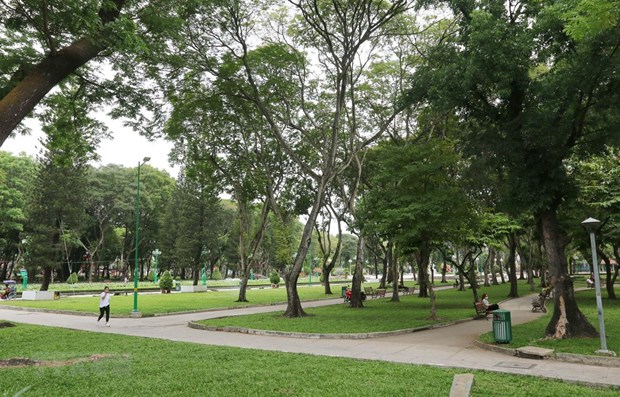
As the world's great cities look to the future, one trend that has become increasingly unavoidable is the development of sustainable green urban areas. This shift is driven by a desire to create better, more livable environments for citizens and to improve their overall quality of life.
 |
| Illustrative image (Photo: VNA) |
In Vietnam, a growing number of cities and municipalities are embracing this trend and are making plans to develop green urban areas that will help to protect the environment and support healthy, thriving communities.
Reality of green cities
According to the Technical Infrastructure Department, the average tree density across Vietnam is only 2-3 sq.m per capita. This is a low figure compared to the criteria of the United Nations of 10 sq.m per capita and one-fifth to one-tenth of the number in big cities worldwide, which is around 20-25 sq.m per capita.
In Ho Chi Minh City, although national standards indicate tree density is 15 sq.m per capita, the actual figure is much lower, at only one sq.m per capita.
The total area planned for public parks in HCM City is 11,400 hectares, which equates to a tree density of 7 sq.m per capita. However, only 500 hectares are used as parks, which is only a mere 0.55 sq.m per capita.
HCM City needs to plan and build "green belts" around the city, according to Dinh Quang Diep, former head of the Department of Scenery and Flower Garden Technology.
Diep's suggestion is because land reserves for green development in central urban areas, such as in Districts 1, 3, 4, 5, and 10, are no longer available. New urban areas in development need green areas to accompany the concrete architecture.
HCM City authorities have been raising the criteria of land reserves for trees in the city while trying to fulfil the current plans for developing parks in the city.
HCM City plans at least 150 hectares of parks and 10 hectares of public greenery from 2021 to 2025. The city will need to plant 10 million trees to get this done.
In Bien Hoa, Dong Nai province, where six industrial areas are present, the economic development has brought about a great rise in population and urbanisation.
Bien Hoa is the most populous Class I urban area in Vietnam, with more than 1.15 million residents. This high population density has made the land reserves in the city smaller, leading to a decrease in land for trees.
The Ministry of Construction's technical regulation states that Class I urban areas must have a tree density of at least 6 sq.m per capita, but Bien Hoa currently has just over one sq.m per capita.
To meet up with demands for green development, Bien Hoa is focusing on reworking its plans for 2030 and 2050.
Opening up a greener space
For years, the green development of HCM City has been tied to the development of infrastructures. However, the speed of green development has never caught up to the speed of urbanisation, especially in areas such as Thu Duc, Binh Tan, Binh Chanh, and Nha Be.
Experts suggested that HCM City must tightly manage the areas planned for parks that have been misused. Urban and residential projects must seriously commit to building parks for a more harmonious environment.
Thu Duc city has ordered 34 wards to gather feedback from residents to build a general plan for 2040 to 2060. The wards are also ordered to review the current public land reserves planned for parks.
HCM City should have a policy that allows social investments in developing public parks of 10 hectares or more, said Nguyen Dinh Hoa, architect and urban planning expert.
Hoa suggested the parks provide proper ways of generating their own income, such as paid amusement parks, art exhibition areas, and indoor or outdoor gyms.
To achieve their tree density criteria of 3-4 sq.m per capita in 2030, HCM City has started a campaign, "Every resident plant a tree".
Funding and human resources, and volunteers have also been called in their quest to plant ten million trees by 2025.
The city also focuses on building legal frameworks and policies that attract investors to build greenery parks. The government will plan for each of these projects, build policies to gather investment, and manage policies to develop and maintain these parks.
In Bien Hoa, Dong Nai, the authorities have been focusing on the development of new parks and greenery across the city in recent years.
Do Khoi Nguyen, chairman of the Bien Hoa People's Committee, suggested the city be allowed to enact their own measures to increase the tree density rate.
The city will gather investors to build parking lots which had to incorporate areas for greenery. The investors of these parking lots are also responsible for managing and developing green areas.
Smaller parks are also planned to be built in the city, which would also meet the demands for recreation of the public, as well as increase the urban green areas./.





![[Infographic] Con số và sự kiện ngày 8-12-2025](/file/e7837c02876411cd0187645a2551379f/122025/thum-con-so-va-sk_20251207210329.jpg?width=400&height=-&type=resize)









